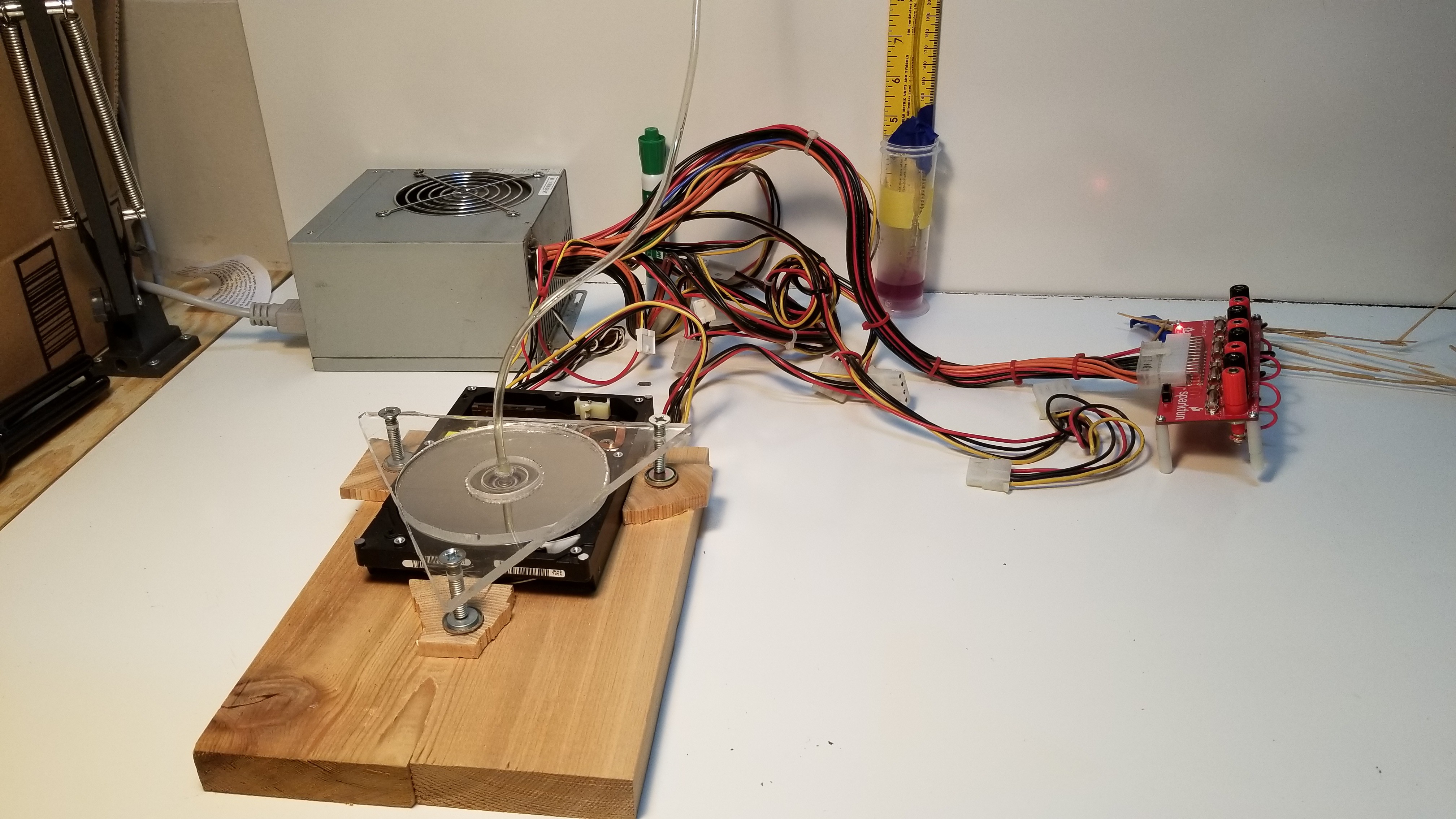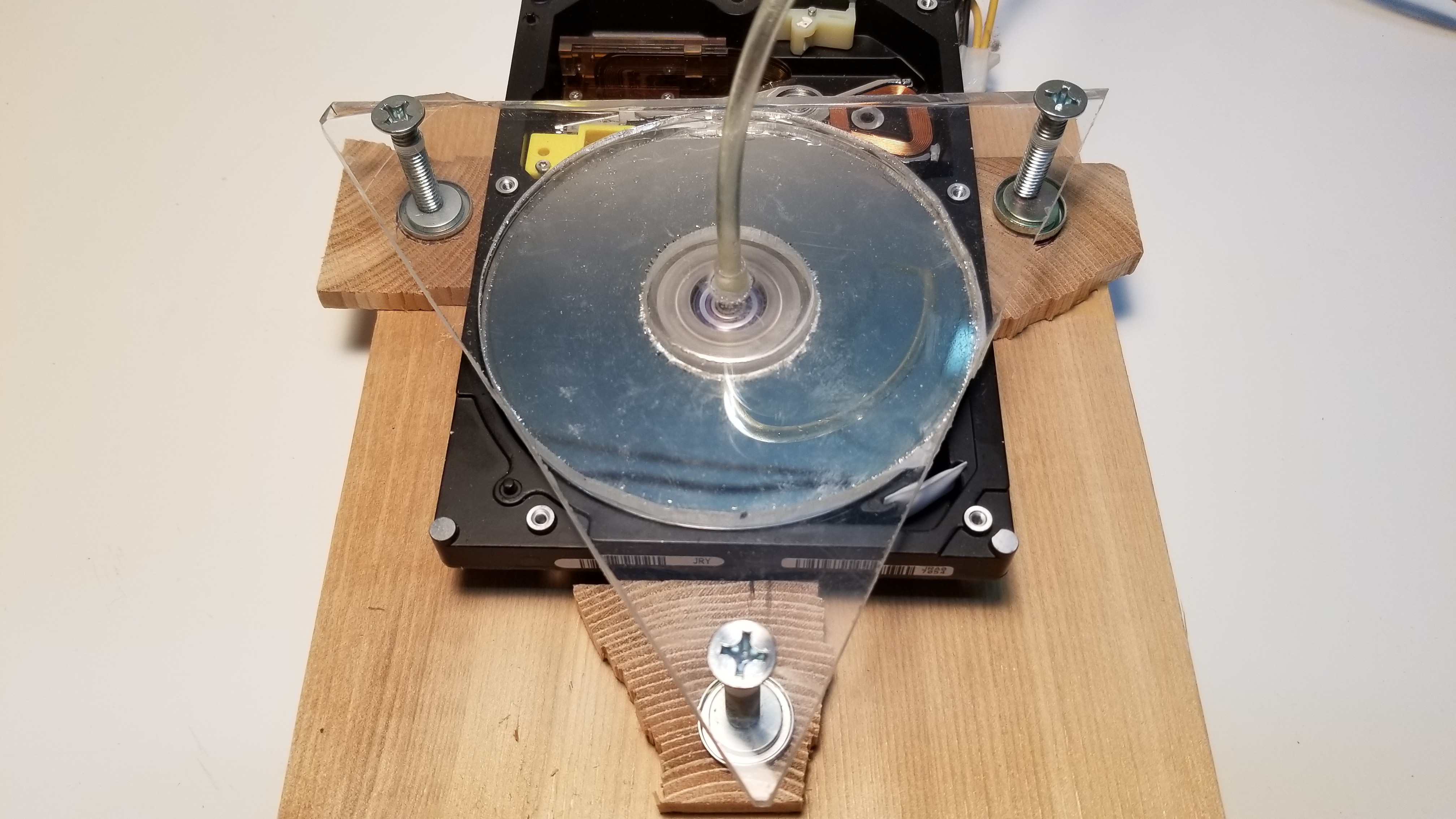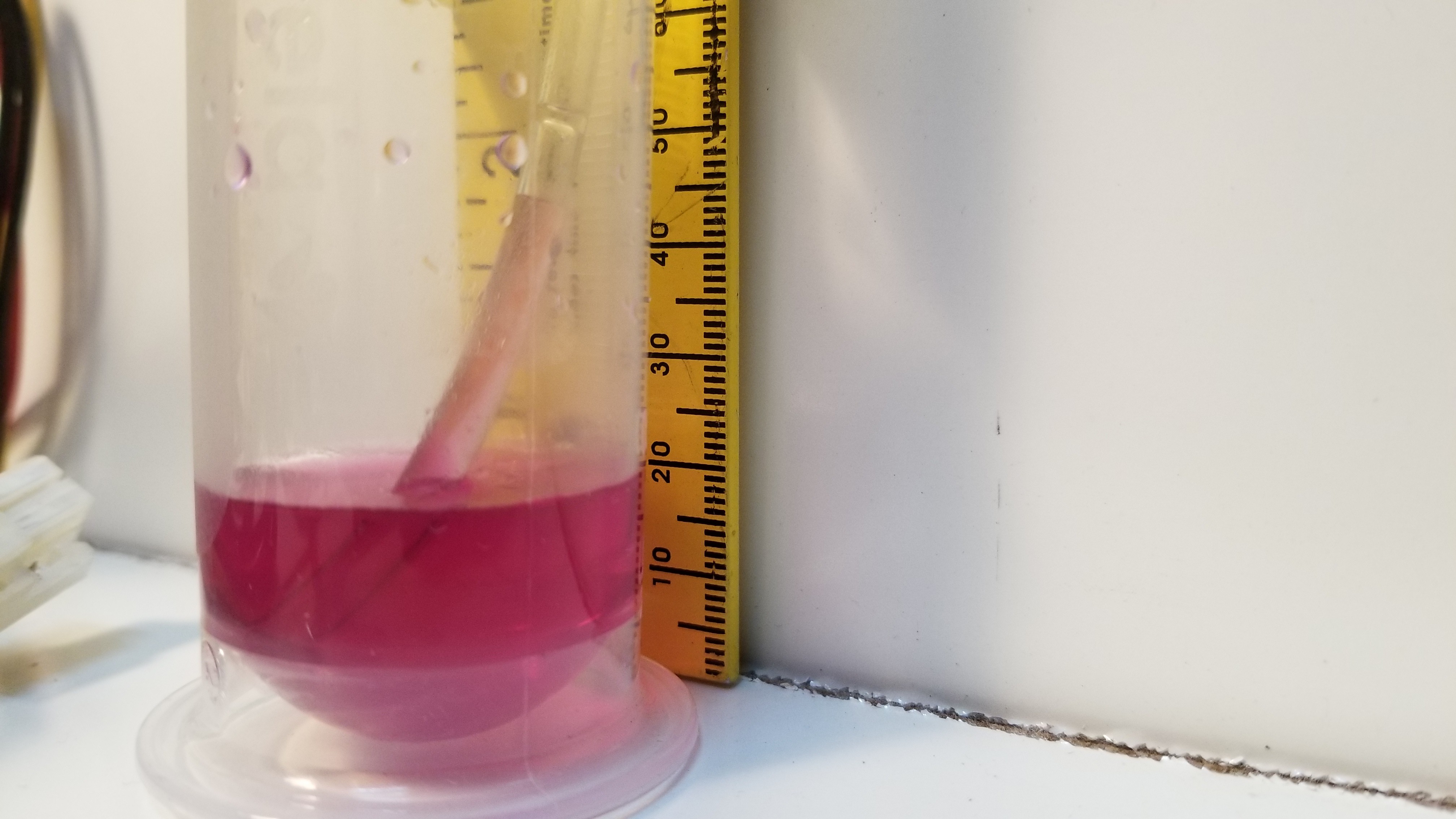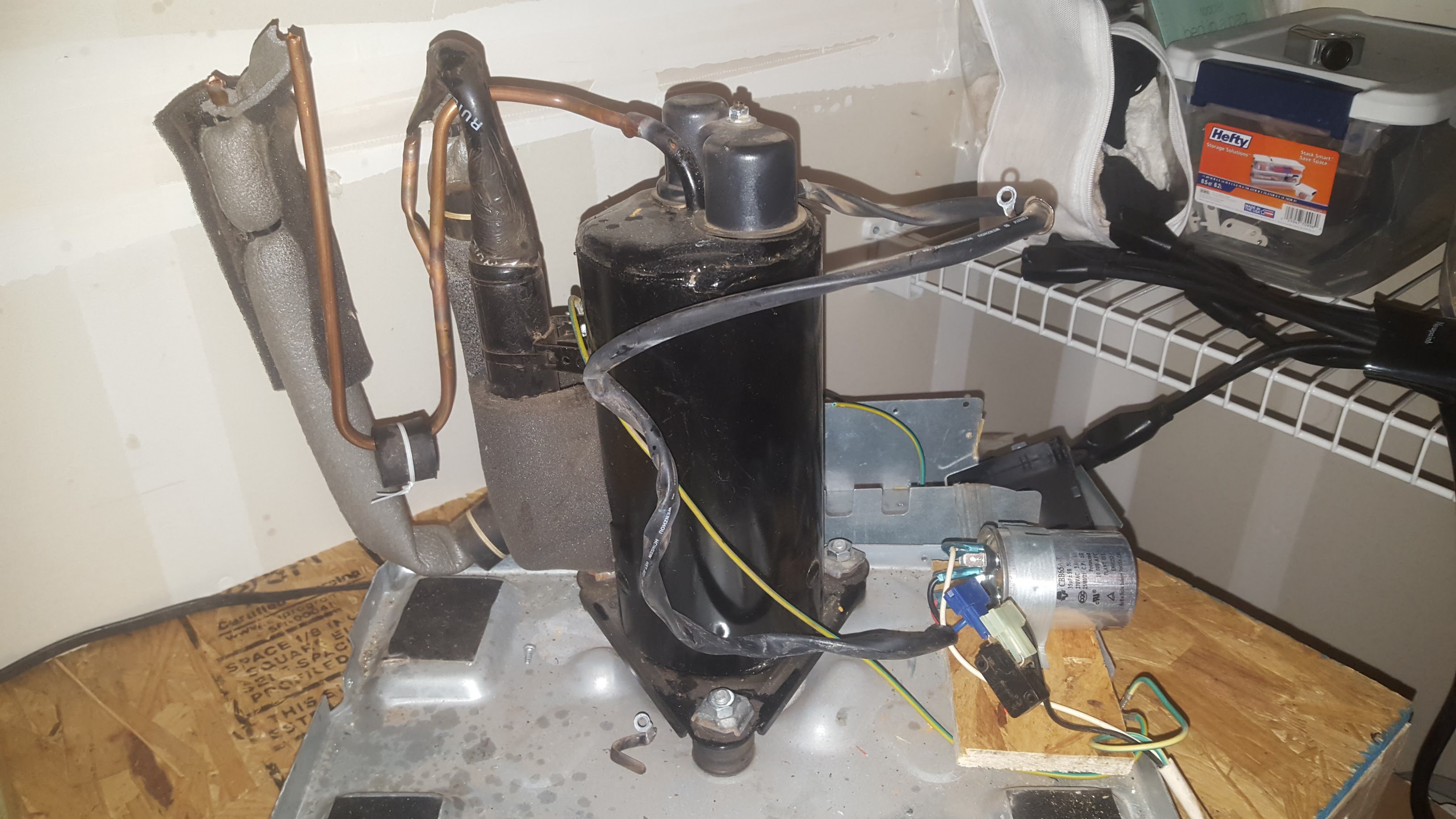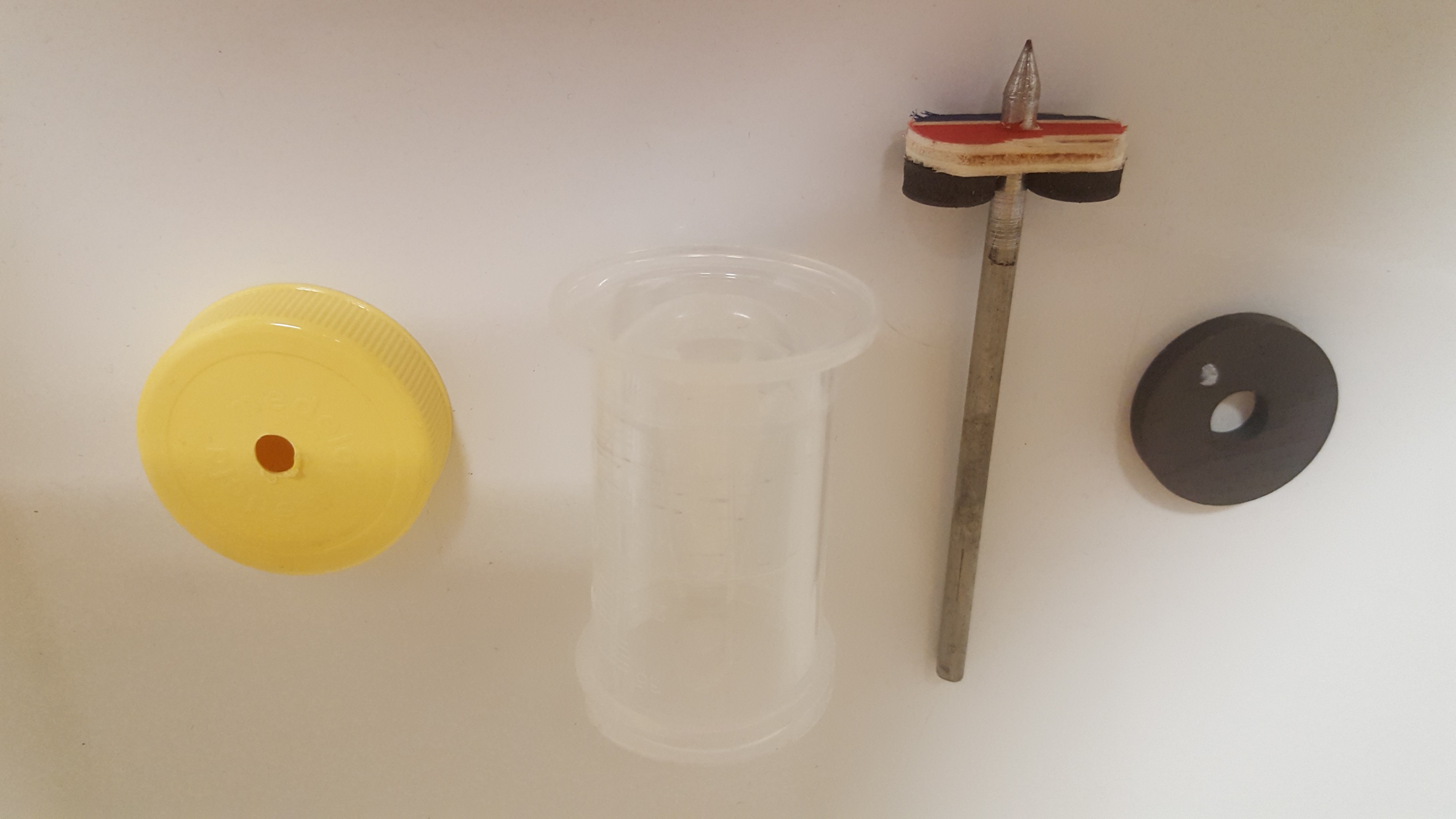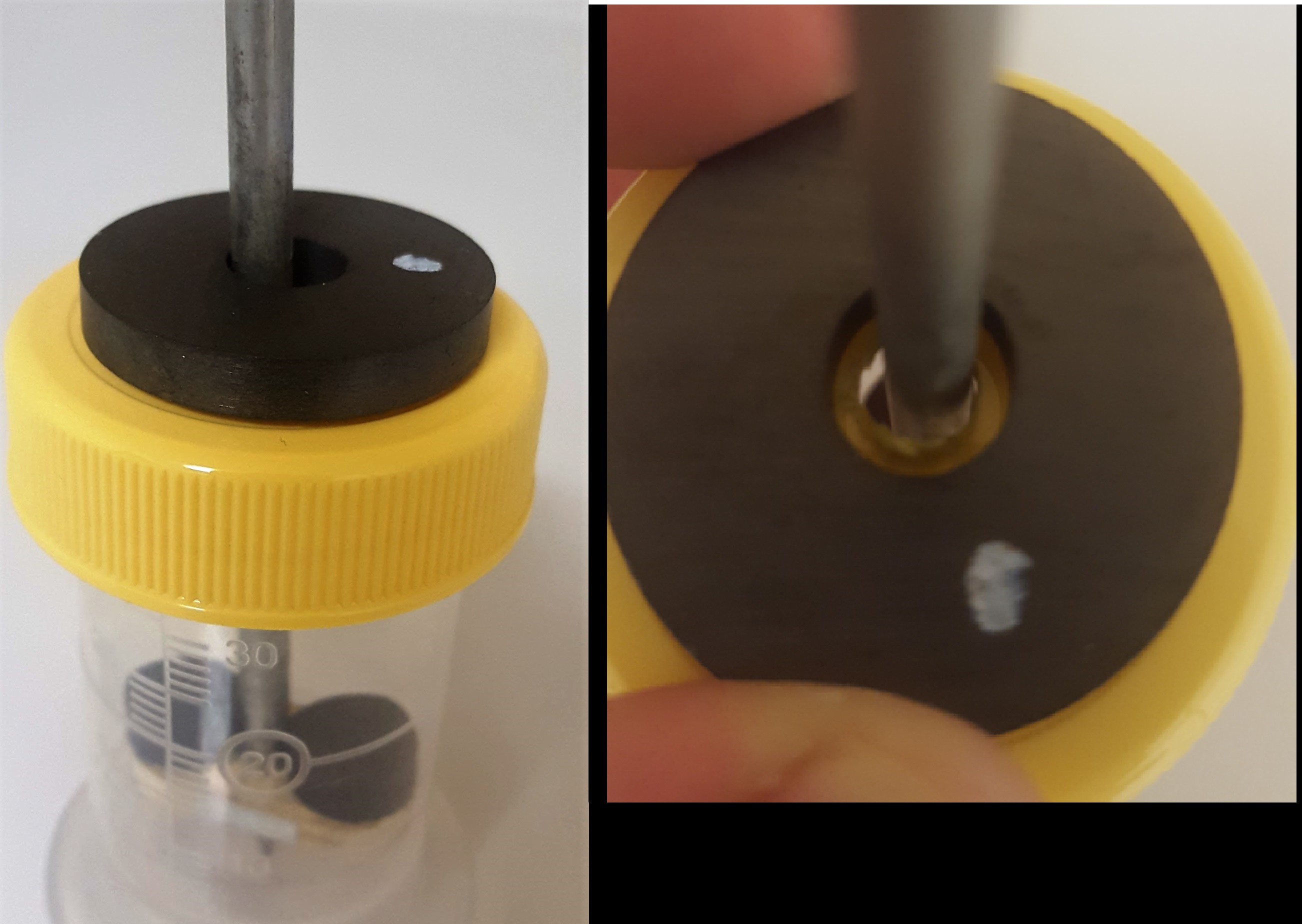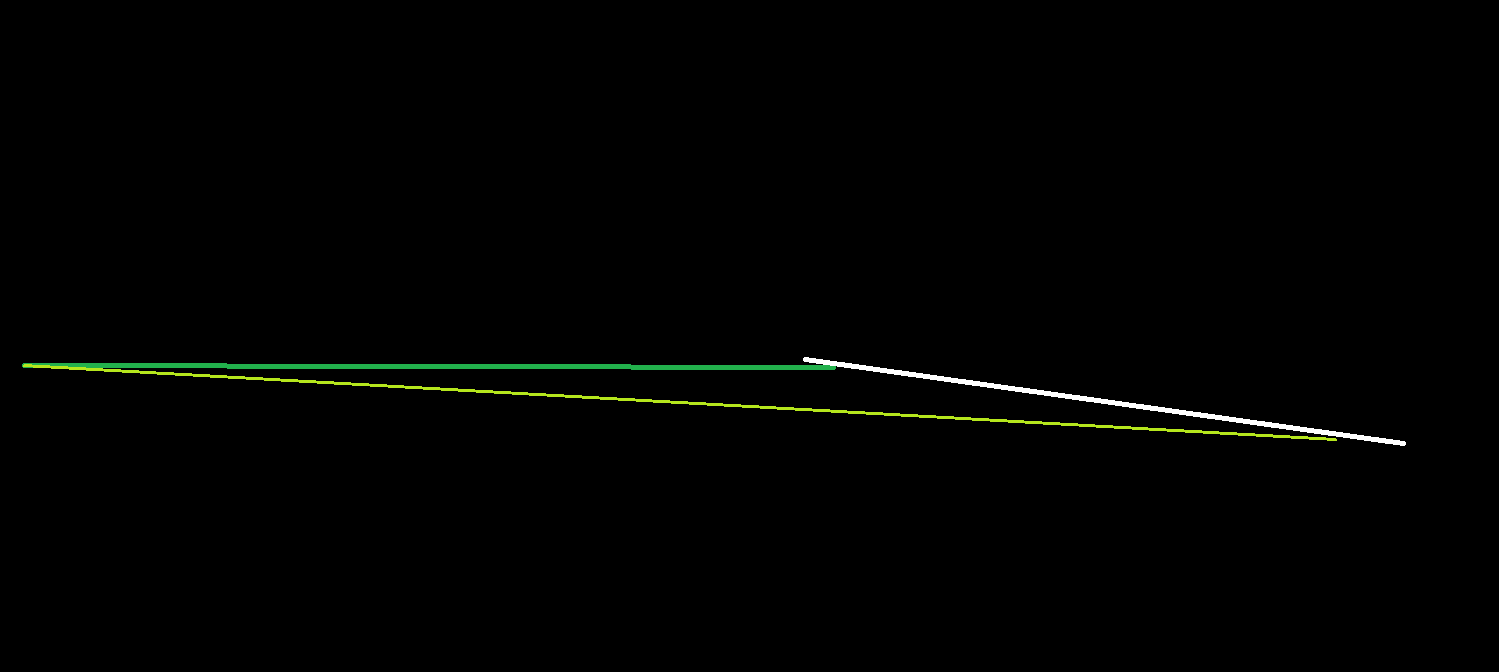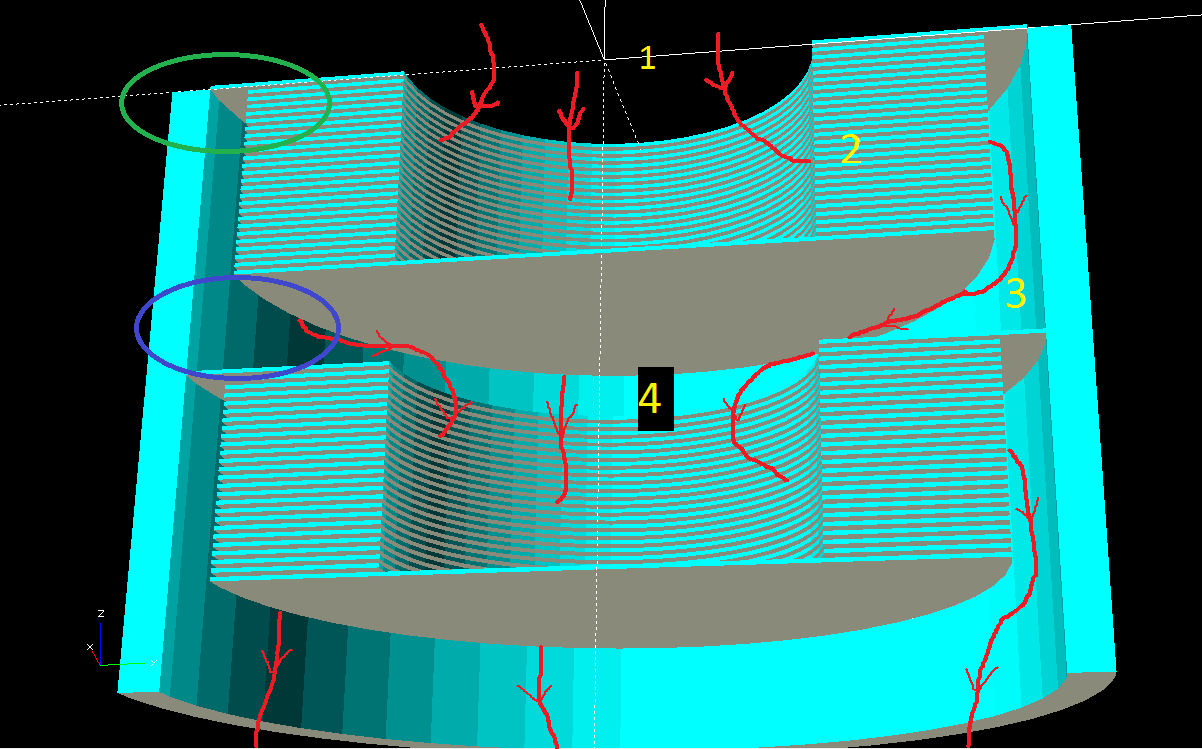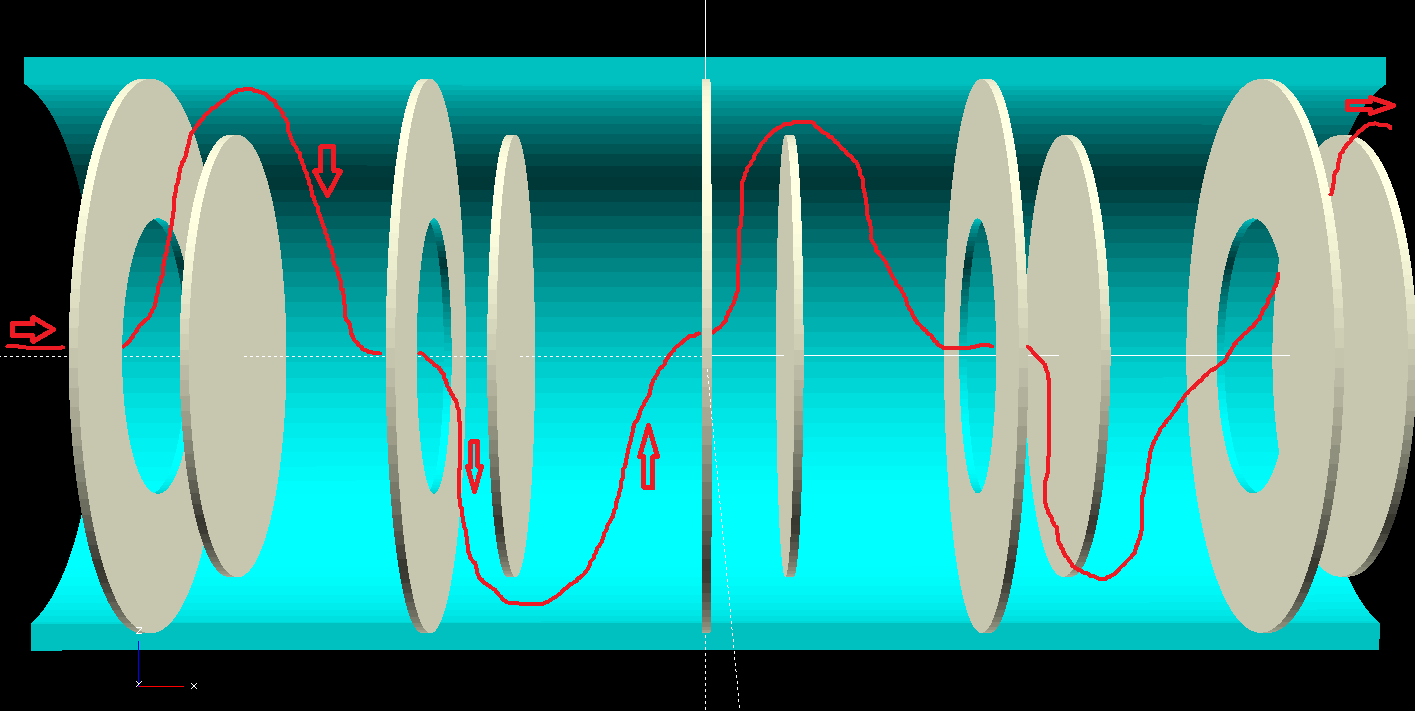-
First experiments with disc "vacuum" pump
03/19/2018 at 20:49 • 3 comments![The Setup The Setup]()
Top left: old PC power supply, front: Hard Disc Drive Test Assembly, back wall: yellow ruler with water filled tube to measure vacuum pressure Welcome back folks! It's been a long time since I've been able to make any headway on this, had to wait a while to scavange just the right parts. I got a free PC power supply and some old hard drives, and decided to massively simplify the device in order to run some very initial experiments and verify my hypothesis. I did NOT expect this to approach anywhere near "high vacuum" or even what could be considered decent "roughing vacuum". This is a highly simplified device to test the relationship between gap width and peak pressure differential produced.
In brief, the device was far less effective than even my meager expectations had allowed. I may yet submit this to "Fail Of The Week." However, it did work well enough to show that a smooth rotating disc can indeed pull a slight vacuum against atmospheric pressure. To my knowledge, this has never been tested before in the literature I could find.
The Setup: Rotor, Stator, and Motor
![Main Test Platform Main Test Platform]()
Main test platform, consisting of HDD with cover removed and read head repositioned. The stator is the clear acrylic triangle mounted above, positioned by 3 fine bolts A HDD makes an ideal rotor, as it is perfectly balanced for high speed operation and perfectly flat to allow extremely small gap widths. For this experiment I am simply using the stock circuitry to drive the motor at its intended 7239 RPM. In future experiments I may attempt to make that speed adjustable. The stator is made of clear acrylic (eventually I hope to observe Newtons rings to fine tune the gap width and stator position), and also forms the bottom of the "vacuum chamber". It leads directly into the pressure measurement tube (center). The stator angle above the rotor is tuned by carefully turning the 3 point bolts to make it as parallel as possible. The bolts are fixed to the platform on 3 strong magnets.
The Setup: Pressure Measurement
![Simple Vacuum Measurement Simple Vacuum Measurement]()
Water and food coloring, pushed up the clear tube leading to the center of the stator. Height of the water column is read on the yellow ruler in the background. Measurements are in cm
Pictured above is the best result I could get on my first day, 2.4cm of vacuous glory, barely 0.036 PSI below atmospheric pressure. Using a water column has several distinct advantages. It is super cheap, and requires no calibration, since the height of a water column is already a standard measurement of pressure differential.
Results and Discussion:
There were a number of problems with this setup, mostly due to it being hastily "hacked" together. This is Hackaday after all.
Problem 1: The acrylic stator was not perfectly flat. If I rested it directly on the HDD before turning it on, the acrylic could be rocked back and forth, so it was somehow bent lower in the center. This limited the minimum gap width I could achieve to no less than about .5mm.
Problem 2: The bolts are too wobbly. The stator had a tendency to wobble laterally, causing the center to crash into the raised center mount on the HDD.
Problem 3: My gap measurement technique was not accurate enough to get anything other than qualitative results like the above picture. It is working, but both the gap measurement and stator positioning are too inaccurate to extrapolate any sort of generalized functional equation of performance to guide future engineering efforts.
I will have to address these 3 problems before I can get more useful data out of this setup, but I do think there is more to be learned from it given those tweaks.
On the plus side, I have verified that Tesla type disc rotors can indeed work as (rudimentary) vacuum pumps, even at atmospheric pressure. Qualitatively, the level of vacuum produced (height of water column) did seem inversely proportional to the gap width between rotor and stator, as my theory had expected. Given those, it does seem possible to create a single stage high vacuum pump that can back itself to atmospheric pressure, given a smooth enough rotor/stator and tight enough gap width. At least we're finally out of the realm of pure theory.
Update as of 21 March 2018
I quickly sanded the acrylic disc flat, just to see if that would have any effect. It made for a remarkable increase in vacuum pressure, as I was able to get the stator and rotor much closer together before any part started rubbing on the other. I ran into another difficulty. I had previously relied on the HDD itself being held down by gravity. With the newly effective vacuum forming, it was enough to lift the entire HDD up, causing the rotor to crash into the stator. Once they became extremely close (and started touching), the motor got overpowered and began slowing down. Because of this, getting a solid stable reading of the resulting vacuum was impossible, however I estimate I saw at least 9-10cm of H2O (0.14 psi) briefly.
For more comparison/guesstimation, the disc radius = 1.9 inches, so disc area is about 11.3 inches^2. The HDD weighs 0.86 pounds. So at its peak, the pressure differential was at least as good as 0.86/11.3 = .076 psi. So I'm confident I hit somewhere in the ballpark of .076 to .14 psi below atmospheric pressure.
I think with this development I have reached the limits of what I can learn from this rudimentary setup. I will have to design and build a much more solid and precise platform before I can get any more significant or measurable pressures. I need to HDD solidly locked to the same frame as the stator, and I need a more precise Z movement. This version of the stator is much too wobbly.
-
In science, never say 'oops', only 'Ah, interesting!'
06/21/2016 at 12:32 • 0 commentsStill poking away, but I'll be out of town a lot soon for work, so we'll see how this goes. Used some silicone caulk to make a seal a couple weeks ago, and stuck an empty jam jar over it just to see what would happen. Also made a crude crookes radiometer to get a rough idea how close I was getting to the needed roughing vacuum.
I never got my radiometer to spin, even in direct sunlight, though I couldn't tell for sure whether the issue was with the vacuum or the radiometer itself. That's the problem with trying to get two experiments working at the same time.
Anyway, I left out alone for a while to think, and came back to it about a week later. To my dismay, the vacuum had managed to pull a bunch of oil out of the vacuum pump and collected out in the jar. This was going to be a royal pain to clean up now. Oops...
Then I noticed the bubbles, streaming in from all around the edges. The issue is at least with my silicone seal! Ah, interesting. The good news is this means there's still a chance my cheap pump might work. Here's a link to video of you really want to see the bubbles.
https://goo.gl/photos/xtBzxkbGbeoLadc76
Back to the drawing board...
-
Got a roughing pump working!
04/26/2016 at 03:18 • 0 commentsWork has still been busy, it's been tough to get time in my garage lately. However I did manage to get an old de-humidifier taken apart, I'll be using the the compressor as a makeshift roughing pump. I got it all wired up, the pump starts and runs great. I used instructions from here: http://www.belljar.net/refrig.htm
Next I need to build a small chamber and see how low this free pump can go. I'm hoping for about 1 Torr. I have a small, decently thick aluminum plate, and I'll place a jar on top of that, upside down. Anyone have ideas for how to seal a glass jar to the aluminum? I'm thinking I'll polish the aluminum real good and start with a scrap of rubber from a bike tire. (this is just for the rough vacuum chamber, no high vac stuff needed here yet). Other thought is to use a bead of silicone caulk. Thoughts?![]()
Also, I thought of another neat way to "measure" the vacuum inside. Partly, @DeepSOIC wisely pointed out that I'm likely overreaching with my "optical vacuum measurement" idea (see the last post). Partly, I've just always wanted to see if I could build one of these radiometers. I tried when I was 7 years old, but didn't realize you needed a vacuum to do it. Anyways, according to @Ben Krasnow these things start spinning in the millitorr range, about the right vacuum I think I need to make the discs work. My junk pile roughing pump will probably not get down low enough to make it spin well, but it's worth a shot. So, this would be a VERY crude but hopefully super accessible way of measuring the vacuum in both the rough and high vacuum chambers.
Put one radiometer in the rough vacuum, and if it spins then you've got a good starting vacuum. Put a second one in the high vacuum chamber. If it stops spinning (while the rough vac radiometer keeps spinning), then you've got better than 6x10^-4 torr. Not exactly a "high" vacuum, however for a proof of concept to see if this whole disc idea has any promise at all, it's a start. And I can build these with aluminum foil, a sewing needle, a magnet, and black spray paint. I think...
-
Passive magnetic bearing prototype. Needs work.
03/30/2016 at 17:21 • 1 comment![]()
So I finally built something! It's just a crude device to test the magnetic bearing idea. Doesn't work very well, but was useful to guide the design further.
It all goes together in the little plastic bottle. Needle bearing works well on the concave bottle bottom, but would spin much better I think if it was against glass and not plastic. And if I made the tip sharper. The main problem is the magnet sucks the axle over too forcefully when it's stationary, so the axle rubs against the yellow cap's hole too much. I was just using my fingers to spin it so far, and was never able to get it going fast enough to even see if the magnetic bearing thing would work.
![]()
What that means for the pump is that we would either need a decent mechanical bearing (i.e., not just a plastic ring) small enough to hold the axle away from the magnet, but large enough to allow the axle to spin freely when it get's up to speed enough for the passive magnetic effects to kick in. Part of the point of the magnetic thing though was to reduce complexity and avoid having to source special bearings, and worry about the grease in high vacuum.
Another option I discovered though while messing around with it is to simply hold a magnet about 1/8 of an inch above the top end of the axle. It keeps the axle upright without touching it, and allowed me to get it going very fast just by blowing on the lower horizontal bar (I was just holding the axle outside of the bottle this time, holding the magnet above. Any old magnet would work for that, it wouldn't have to be a ring magnet or anything.
A second option would be to make a "active" passive bearing, by using a solenoid coil instead. Then it could be turned off until the axle got up to speed. But that requires power to get inside the chamber somehow, whether through pass throughs or more coils.
A third option would be a combination. A permanent magnet, with a coil around it that cancels out the magnetic field of the magnet until the axle got up to speed. Then the coil could be turned off, power removed, and the chamber cover set in place. That sounds complicated to me though.
I'm thinking the first option (magnet held above the axle) is going to be the best.
-
Vacuum measurement
03/22/2016 at 22:04 • 7 comments***UPDATED 1 May 2016***
I've decided to shelve this idea, some wise people pointed out a lot of problems that would be difficult (impossible?) to get around. Instead I'll be using a Crooke's radiometer to get a rough idea of how the vacuum is doing. See later project logs. Leaving the original post here for posterity.
**************************************************
ORIGINAL POST:
First of all, I wanted to say thanks to everyone who followed/liked my project, and especially thanks for the comments and ideas you've shared with me. A lot of this is way out of my normal area of expertise, so I'm learning a lot along the way.
This post is about finding a way to measure the vacuum, so that we have some way of tracking the pump's performance. There are lots of ways to do this, many of which could be done pretty cheaply. All require some sort of electrical pass through though, and to give myself the highest chance of building a working chamber I've been on the lookout for ways to eliminate those wherever I can. I had the idea of using a laser interferometer with one path shining through the vacuum. As the vacuum increased, the path length would change slightly, and might be able to be picked up. So I did some googling, and ran across an even simpler idea here (pdf). All of what follows comes from that paper, so credit is due to [Hasan Fakhruddin] for coming up with the idea. I'll rewrite it here in my own words so I can expound a little.
Here's the setup: shine a laser through the glass vacuum chamber into a diffraction grating placed inside. After the laser passes through the grating and the other side, look at where the 1st order beam lands on the wall. The beam will be deflected varying amounts depending on the index of refraction of the near vacuum inside. The difference in deflection angles is very slight, so we'll have to find a way of amplifying the signal. Not sure yet if this will be possible. The change in deflection angle may be less than the beam width of the laser. But it's worth a shot because it has some distinct advantages:
1. No pass throughs required at all. Just need a transparent chamber wall.
2. Minimal materials required. Laser pointer and an old CD-ROM is about it. And a wall. Might need some mirrors.
Here's some numbers to get an idea of how realistic this is. Here's the deflection equation, from the paper cited above:
I happen to have a 532nm green laser pointer on my bench, so I'll run some numbers with that. I put a small excel file in the project documents section if you want to try these calculations with your own materials at hand. If we use an old CD-ROM as a diffraction grating, that gives us 625 lines/mm, or
d = 1.6x10^-6.
Lambda is 532x10^-9 m for air, and 532.15428x10^-9 m for vacuum.
With M=3 (third order beam), theta (air) = 85.947 degrees, and theta (vacuum) = 86.190 degrees. So dTheta is 0.242 degrees. This is the total width of our measurement "signal" if you will. If we reached perfect vacuum, the beam would move .242 degrees on the screen. So, not much to work with, but we might be able to amplify it. I'm open to ideas. Putting the screen really far away, or bouncing it off a mirror that's really far away and back to a screen close to me is one option. Putting the screen at an extreme angle to the laser is another option, so that a small change in angle moves the dot a large amount across the screen (super simplified sketch below).
![]() Of course this also means the beam dot will kind of "smear" across the screen, it might be pretty wide, and hard to make a specific reading. I guess all I can do is try it!
Of course this also means the beam dot will kind of "smear" across the screen, it might be pretty wide, and hard to make a specific reading. I guess all I can do is try it! A quick note on selecting materials. In terms of wavelength or diffraction grating lines, more is not always better. The real goal is to get the deflection as close to 90 degrees as possible, without going over. That seems to maximize dTheta. The wavelength of the laser and the lines/mm of the grating have to be balanced to hit that. Also, if you can get the 1st order to be close to 90, vs. the 2nd or 3rd order, the usable dot will be brighter.
-
Turbopump V 0.2 - Single stage lives again!
03/20/2016 at 06:11 • 9 commentsAlright, when we left off 4 months ago, I had been thinking we'd have to use multiple stages to reach our goal vacuum. However, the seals between stages were going to introduce a LOT of complications. I think. I didn't build anything, so far this is all just intuition. The other development is that I learned, thanks to [DeepSOIC], that discs tend to warp badly at high speed. He graciously proved experimentally that this warping is not an issue in rough vacuum, and the discs will spin smoothly and easily. See discussion on project page if you're interested. This does mean that a rough backing pump will be required just to get our disc pump up to speed safely. It's not the end of the world, decent backing pumps are like $100 at Harbor Freight, and can be found for free in old air conditioners.
4 months ago I also mentioned I thought I had a way to get back to a simple single stage pump design. Here it is.
The multiple stages was originally predicated on assumptions about the compression ratio of each stage, given a specific outer edge speed of the rotating discs. The max speed we're realistically (safely?) going to get is about 300 m/s with aluminum. At best. That gives a 1.6 compression ratio, 14 stages to a rough vacuum. However, as [Comedicles] astutely noted, the notion of pressure in the typical sense is basically meaningless when describing the flow of gas molecules at high-mid vacuum. There is no boundary layer, and the pump's operation can be better understood kinetically. As long as the mean free path of the molecules is larger than the gap width between the discs, they will not interact with each other in any "pressure gradient" producing way. They will simply (mostly) bounce between the two discs, picking up energy and gradually moving outwards.
Here's the key. If our roughing pump can bring the pressure low enough, and our discs are spaced closely enough, the pump will work. How low of a vacuum it will produce is more a function of how quickly it can move molecules to the outer edges, and what kind of chamber outgassing we're dealing with. If anyone knows how to do that kinda math I'm all ears. It'd be pretty cool to run a simulation of the particle kinetics.
Here's the new design, with a few numbers thrown in to make it sound more real.
1. Get a nice donut shaped cookie cutter from the kitchen, a cutting board, and a roll of aluminum foil. And some kind of thin star shaped cookie cutter too. Not sure if those exist yet.
2. Stack a bajillion alternating donuts and stars until we get about an inch thick total. The donuts are the discs of course. The stars act as hubs, spokes, and spacers between the discs.
3. Mount this mess to a small aluminum rod I got from Lowe's, stuff it inside an empty pickle jar, add a motor, and we have a pump! Hey, this is HACKaDay, right? haha. In all seriousness...
Roughing pump pulls chamber down to 100 Pa. The Harbor Freight pumps are rated down to 10 Pa, but let's assume that with the disc pump chamber and tubing and everything attached we only get 100 Pa. That put's the mean free path of air at .07 mm. Width of standard household aluminum foil is .016 mm. Perfect. We can use aluminum foil as both the discs and spacers.
That covers the axle and discs. Next:
Bearings: The bottom we can simply file the aluminum axle to a point and set it on a concave piece of glass as a makeshift needle bearing. I did actually try this, it works. Didn't try it at 60,000 RPM yet though... At the top, we can use a hollow cylindrical magnet. It might work like an electrodynamic bearing, I hope.
Motor: This will be a rudimentary, horribly inefficient, brushless DC motor. I think that's the easiest way of spinning this thing without creating the need for extra seals or electrical pass throughs and craziness (i.e., sources for leaks). The bottom disc will not be foil, but actually 3D printed PLA or maybe machined aluminum disc with 3 spots to place strong permanent magnets. Directly below, but OUTSIDE the chamber walls are our 3 coils. This way, the simplest part of the motor (the magnets) are the only thing inside the vacuum chamber, and we don't need any electrical or rotating mechanical pass throughs. It will not be very efficient at all, because of the distance between the magnets and coils, but who cares as long as it can still get enough power through the chamber wall to spin up ok.
Motor controller: I had toyed with the idea of using my FPGA, it seemed my mBed microcontroller would be too slow to handle the timing for extremely high rotation speeds. However regular BLDC quadcopter motors are so darn cheap that it's worth trying one of those just to see if it can be made to work. Thanks to [Ben Krasnow] for pointing this out in one of his recent videos.
Chamber: Oh boy. This part needs some work. You guys that know vacuum stuff are going to get a kick out of this. I'm glad most people have stopped reading by now, this post is so darn long. Here's what I'm thinking so far. Regular food jars stay vacuum sealed for months or years. Yes, they're not at high vacuum, but if the seal holds for that long with even a rough vacuum they're good enough that I really want to try it out. It might be a waste of time, but I'm curious. So, start with one big pickle jar, right side up, sitting on top of the 3 motor coils. In the lid, we drill two holes. One large one for the high vacuum chamber tube, and a small one for the roughing pump to plug into. Then solder this lid to a nice thick sheet of aluminum stock, lined up on a hole through the sheet for the high vacuum again. Above the aluminum is another jar lid, soldered on upside down with a hole lined up on the aluminum again. Screw a jar onto that second lid upside down for the high vacuum chamber. Ridiculous I know. If I can figure out a better way to seal the glass jars to aluminum I could skip the lids altogether. The coating inside those lids is probably no good for high vacuum stuff.
Anyways, those are the latest thoughts. Sorry this was a long post, but it'd been like 4 months so had a lot to catch up on. Next time I'll talk about how to measure the vacuum. ttfn!
-
2016 Hackaday Prize! And update...
03/16/2016 at 02:40 • 0 commentsSo just in case anyone is still following this project, here's a quick update. I had to relocate across the country for work and medical reasons, so tinkering and projects had to be shelved for about 4 months. The chaos is starting to subside now, and with the launch of the 2016 Prize it's time to dust off this vacuum pump idea and maybe actually build something at last. I'm not going to beg you for likes. If you think this project deserves one go for it, if not there are tons of other great projects out there. But be sure to browse the list of entries and throw your vote in somewhere. I'm open to more contributors too if this idea really catches your eye.
On the technical side of things, I've had some hopefully useful ideas in the interim. Watch for some posts soon about how I plan to build the motor and discs, as well as the overall plan of attack for the build. It's going to have to be in several incremental stages, with specific experiments along the way. I also have some ideas on alternative, optical methods of measuring a vacuum that could be easier and cheaper than current sensors. Lastly, I scavenged an old compressor off a broken dehumidifier, it should make for a half decent backing pump. Here goes nothing...
-
Exploding disc test 1 (failure)
11/03/2015 at 01:54 • 6 commentsThis test was a hack in every sense of the word. I just wanted to try spinning something for fun, so didn't bother taking any video (it wasn't very exciting in the end). I will try to describe what I saw, there were some interesting things to ponder.
I began with a crudely cut disc of regular paper. It was crudely cut because I couldn't find my protractor or compass right away, so just folded it diagonally about 5 time then cut the corner off with scissors. It was pretty close to circular, but had little lobes on the edge. I don't think it mattered as much as I thought it would. About 8.5" in diameter. I duct taped this to a cutting wheel on my Dremel and turned it on.
First test at 5k RPM it spun beautifully. Despite the folds and creases and poor cutting job it flattened out instantly and felt very smooth. Looking at it edge on it formed a nice thin edge, the forces flattened and stiffened the disc.
Then I gradually increased the speed and it got much worse about 10-15k RPM. The disc was wobbling or warping or something. Too fast to see, but looking at it edge on, the blur had widened to about 1/4", and I could feel some turbulence.
From just this info it's hard to tell whether this was due to my poor mounting system of duct tape or due to the inherent physics of the system. On subsequent tests with the same paper, I was never able to reproduce the smooth flat spin of the 1st test.
Once the turbulence started I hit another snag, the Dremel maxed out it's power at only about 15-20k RPM. I tried running it faster but it refused to go. I didn't have an RPM gauge hooked up (I said this was a quick hack!), but I could hear the RPM change quite clearly in the lower ranges. Beyond 20k on the dial and the motor didn't change its tune.
This was pretty dissapointing, I had really wanted to make something explode. I really thought paper wouldn't take much at all. Oh well. I have an old unused vacuum cleaner I may take apart and scavenge, I hear those have pretty fast motors. I'll find my compass and cut a proper smooth disc too.
-
One more multi-stage CAD drawing
10/30/2015 at 03:26 • 2 commentsHere is a more detailed render of two stages of a disc pump:
Red lines are hypothetical air streams, minus lots of spiraling for simplicity.
1. Air enters from the vacuum chamber
2. Passes into the thin gap in the discs, where it get accelerated rapidly and flung towards the outside
3. Air exits the discs at hopefully somewhat higher pressure, and follows along the stationary wall, where it begins slowing down.
4. Once it has lost enough energy the air makes it's way to the center intake hole of the next pump stage.
Two problem areas I foresee:
Green oval: The seal between the intake disc and the wall. This disc is the main barrier between the different stage pressures. Considering this disc is also rotating at high speed, I have no idea if it is even possible to make that be a halfway decent seal. Also, this intake disc must be a slightly larger radius than the other discs, making it more susceptible to hoop stresses and explosion. Basically, the rotational speed will be limited by this disc, but the compression limited by the smaller discs. Perhaps the disc-wall gap could be gradually varied, increasing from top to bottom?
Purple oval: Here the air has been given high kinetic energy (speed) from the discs, but must convert that into pressure before it can slow down and enter the central hole in the next stage. In normal centrifugal pumps this is done by the "diffuser", basically a finely tuned set of stator blades that slow the air down again. I had hoped to avoid the construction of blades due to their complexity, relying on friction with the outer wall to slow down the air. I have no idea how well this will work however. It could work fine, or the air might generate a bunch of heat from the friction. I understand that different diffuser design can do this "kinetic energy to pressure energy" conversion with various efficiencies, and I'm guessing the inefficient ones generate more heat and less pressure? But this is just my very uninformed reading of the Wikipedia page on centrifugal compressors. Any aerospace engineers reading this that might have some ideas? Do you think I'll need some kind of stator vanes in between stages?
I have one more design idea for a single stage version that would avoid all of these issues, that'll have to be tomorrow's write up.
-
Simple CAD render of multi-stage tesla pump
10/29/2015 at 04:08 • 0 commentsI learned OpenScad tonight! Thought I'd try out making an ultra-simple model of a 5-stage disc pump. I drew in some red lines to show the path of the air molecules through the pump. This is massively simplified, and the spacing between the discs has been wildly exaggerated for clarity. In a real pump the discs would need to be MUCH closer together to be effective at all. Additionally, this render just shows one hollow disc per stage. Many more hollow discs could be added adjacent to one another within each stage in order to increase gas throughput.
Everyman's turbomolecular pump
(Maybe) access to the high vacuum environment for the rest of us
